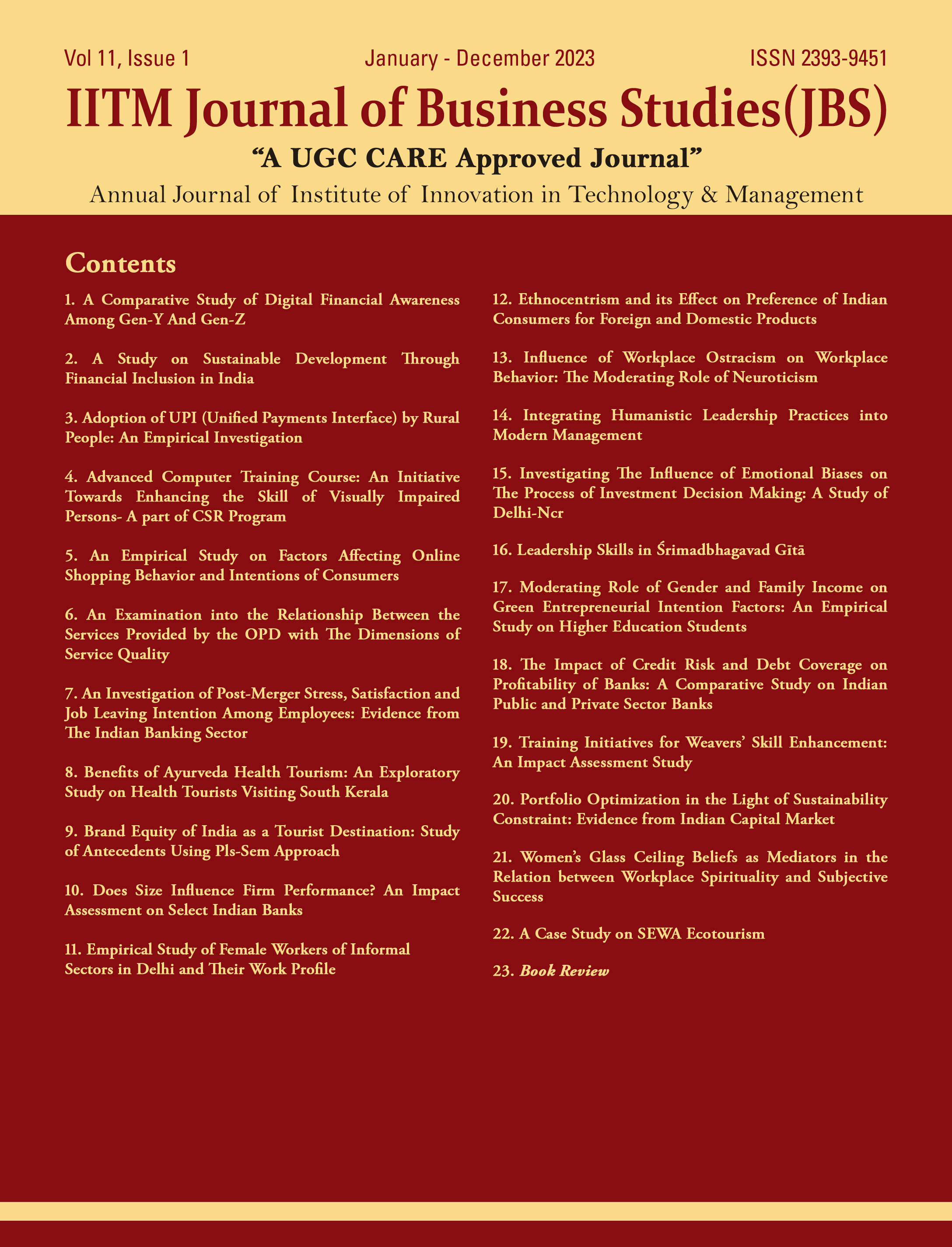Representation of Underrepresented Group: A Case of Women Political Participation
Keywords:
women, gender, inequality, gender gap, policy, empowermentAbstract
Ge n d e r i n e q u a l i t i e s p e r s i s t i n t h e society, particularly in politics, and their underrepresentation is widely seen in higher level positions. The purpose of the study is to briefly examine broad causes, effect of women participation in politics and remedies for due representation. Through academic literature in the area of economics and political science with specific concern about gender inequalities and women’s underrepresentation in politics is globally realized. Further, extensive secondary tools applied to establish factors responsible for women’s underrepresentation, women positive effects in politics and an effective system for their redressal. It is observed that still a misconception existing in the society that women are incompetent to handle core areas of administration like finance, economic development, foreign affairs, defense, trade, and entrepreneurship with particular reference to political and government machinery where women allocate portfolios limited to women-only issues. It is seen that reserving seats for women in politics yield positive outcomes. Furthermore, even after quotas were discontinued, quotas improved perceptions about women as leaders, increased girls’ aspirations, and helped women get elected. In a true democracy, women’s political participation is a precondition for realizing gender equality. However, globally, less than 25 per cent of seats are represented by women in parliament and only 12 per cent of women occupy head of state positions. This disparity is also found in local government in various countries.
References
Beaman, L. (2007), “Women Politicians, Gender Bias, and Policy-making in Rural India”, available at: http://www.unicef.org/sowc07/docs/beaman_duflo_pande_topalova.pdf (accessed 21 October 2022) 2. Beaman, L., Chattopadhyay, R., Duflo, E., Pande, R., and Topalova, P. (2009), “Powerful Women: Does Exposure Reduce Bias?”, Quarterly Journal of Economics, Vol. 124 No. 4, pp. 1497–1540. https:// doi.org/10.1162/qjec.2009.124.4.1497
Beaman, L., Duflo, E., Pande, R. and Topalova, P. (2012), “Female Leadership Raises Aspirations and Educational Attainment for Girls: A Policy Experiment in India”, Science, pp. 582–586. https://doi. org/10.1126/science.1212382
Burns, N., Schlozman, K. L. and Verba, S. (2001), The Private Roots of Public Action: Gender, Equality, and Political Participation, Harvard University Press.
Cammisa, A. M. and Reingold, B. (2004), “Women in State Legislatures and State Legislative Research: Beyond Sameness and Difference”, State Politics & Policy Quarterly, Vol. 4 No..2, pp. 181–210. https:// doi.org/10.1177/153244000400400204
Center for the American Woman and Politics (1991), Reshaping the agenda:Women in State Legislatures, Eagleton Institute of Politics, Rutgers, The State University of New Jersey.
Chattopadhyay, R. and Duflo, E. (2004), “Women as Policy Makers: Evidence from a Randomized Policy Experiment in India”, Econometrica, Vol. 72 No. 5, pp. 1409–1443. http://www.jstor.org/ stable/3598894
Chen, L. J. (2008), “Female Policymakers and Educational Expenditures: Cross-Country Evidence”, SSRN Electronic Journal. https://doi.org/10.2139/ssrn.1117552
Chinkin, C. and Charlesworth, H. (2006), “Building Women into Peace: the international legal framework”, Third World Quarterly, Vol. 27 No. 5, pp. 937–957. https://doi.org/10.1080/01436590600780391 11. Chung, K. S. (2000), “Role Models and Arguments for Affirmative Action’, American Economic Review, Vol. 90 No. 3, pp. 640–648. https://doi.org/10.1257/aer.90.3.640
Ghani, E., Kerr, W. R. and O’Connell, S. D. (2014), “Political Reservations and Women’s Entrepreneurship in India” SSRN Electronic Journal. https://doi.org/10.2139/ssrn.2383423
Gjermeni, E. (2021), “Enhancing the political participation of women from under-represented groups”, available at: https://socialeurope.eu/enhancing-the-political-participation-of-women-from-under represented-groups(accessed 8 October 2022)
Hassim, S. (2006), Democratization: A View from Africa, The University of Chicago Press. https:// www.jstor.org/stable/10.1086/500606
Iyer, L., Mani, A., Mishra, P. and Topalova, P. (2012), “The Power of Political Voice: Women’s Political Representation and Crime in India”, American Economic Journal: Applied Economics, Vol. 4 No. 4, pp.165–193. https://doi.org/10.1257/app.4.4.165
Kalsi, P. (2017), “Seeing is believing- can increasing the number of female leaders reduce sex selection in rural India?”, Journal of Development Economics, Vol. 126, pp. 1–18. https://doi.org/10.1016/j. jdeveco.2016.12.002
Markham, S. (2013), “Women as Agents of Change: Having Voice in Society and Influencing Policy. In Women’s Voice, Agency, and Participation”, Research Series No. 5, The World Bank. http://ysu.am/ files/Markham%202013.%20Women%20as%20Agents%20of%20Change%20Having%20voice%20 in%20society%20and%20influencing%20policy_%20Dec%2017.pdf
Mollmann, Marianne (2011), “Why Women in Politics Matter. Human Rights Watch”, available at: http://www.hrw.org/news/2011/06/24/why-women-politics-matter (accessed 02 October 2022) 19. Rosenthal, C. S. (2001), “Gender Styles in Legislative Committees”, Women & Politics, Vol. 21, pp. 21-46. https://doi.org/10.1300/J014v21n02_02
Schwindt-Bayer, L. A. and Mishler, W. (2005), “An Integrated Model of Women’s Representation”, The Journal of Politics, Vol. 67 No. 2, pp. 407–428. https://doi.org/10.1111/j.1468-2508.2005.00323.x 21. Schwindt-Bayer, L. (2006), “Female Legislators and the Promotion of Women, Children, and Family Policies in Latin America”, Background Paper, The State of the World’s Children, UNICEF. http:// www.unicef.org/sowc07/docs/schwindt_bayer.pdf
Strickland, R.S. and Duvvury, N. (2003), “Gender Equity and Peace Building-from Rhetoric to Reality: Finding the Way”, A discussion paper, International Centre for Research on Women, Washington. 23. The Institute for Inclusive Security (2009), “Strategies for Policymakers: Bringing Women into
Government, available at: http://www.huntalternatives.org/download/1648_bringing_women_into_ government_mar_09_final.pdf/ (accessed 20 October 2022)
Underrepresentation of Women in Politics, (2022), available at: https://esthinktank.com/2022/02/28/ underrepresentation-of-women-in-politics/ (accessed 9 October 2022)
Wilber, Roxane (2011), “Lessons from Rwanda: How Women Transform Governance”, Solutions, Vol. 2 No. 2. http://www.thesolutionsjournal.com/node/887.
